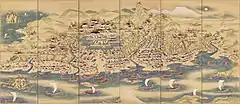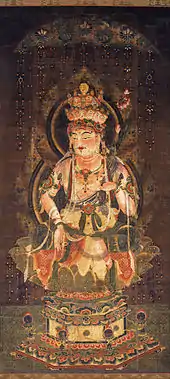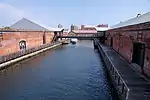List of Cultural Properties of Japan - paintings (Hokkaidō)
This list is of the Cultural Properties of Japan designated in the category of paintings (絵画, kaiga) for the Circuit of Hokkaidō.[1]
National Cultural Properties
As of 1 July 2019, zero properties have been designated as being of national significance.[2][3]
Prefectural Cultural Properties
As of 1 July 2019, five properties have been designated at a prefectural level.[4][5][6]
| Property | Date | Municipality | Ownership | Comments | Image | Dimensions | Coordinates | Ref. |
|---|---|---|---|---|---|---|---|---|
| Sakyamunī's Parinirvāṇa, by Kakizaki Hakyō 釈迦涅槃図蠣崎波響筆 Shaka nehan-zu Kakizaki Hakyō-hitsu | 1811 | Hakodate | Kōryū-ji (高龍寺) | pair of scrolls; this two scroll format is unusual; most of the activity is in the left-hand scroll; on the bottom of the box is the date Bunka 11 (1814), on the back of the mounting that of Bunka 9 (1812), while a note of dedication refers to their being painted in Bunka 8 (1811) for the priest of Kōryū-ji (高龍寺) in Hakodate[7][8] | .jpg.webp) | 2.99 metres (9 ft 10 in) by 1.405 metres (4 ft 7.3 in) | 41°46′07″N 140°41′58″E | |
| Sketchbook for Ishū Retsuzō 夷酋列像粉本 Ishū Retsuzō funpon | 1790 | Hakodate | Hakodate City Central Library (函館市中央図書館) | thirteen studies by Kakizaki Hakyō for the series of paintings of twelve Ainu chiefs who had cooperated with the Matsumae Domain during the Menashi-Kunashir Rebellion;[8][9] in order, Chikiriashikai, Shonko, Ikotoi, Chousama, Poroya, Ininkari, Nishikomake, Mautarake, Nochikusa, and Tsukinoe | .jpg.webp) .jpg.webp)  .jpg.webp) .jpg.webp) .jpg.webp) 2.jpg.webp) .jpg.webp) .jpg.webp) .jpg.webp) .jpg.webp) .jpg.webp) .jpg.webp) | 45 centimetres (18 in) by 42.5 centimetres (16.7 in) | 41°47′54″N 140°45′12″E | |
| Byōbu of Matsumae 松前屏風 Matsumae byōbu | 1754-64 | Matsumae | Matsumae Town Historical Museum | 6 panels, by Kodama Teiryō (小玉貞良)[10] |  | 3.648 metres (11 ft 11.6 in) by 1.57 metres (5 ft 2 in) | 41°26′08″N 140°06′43″E | |
| Ema with the Kamui nomi 絵馬カムイノミの図 ema kamui-nomi no zu | 1899 | Toyokoro | Ōtsuinaka Jinja (大津稲荷神社) | Kamui nomi is a ritual prayer to the kami for bounty; the ema, by Kawanabe Kyōsai, shows the Tokachi fishing grounds were harvested by the Ainu[11] | .jpg.webp) | 42°41′12″N 143°38′53″E | ||
| Votive ema from Itsukushima Jinja 厳島神社奉納絵馬 Itsukushima Jinja hōnō ema | C19 (first half) | Mashike | Itsukushima Jinja (厳島神社) | seven ema, including a rare example on glass[12] | 43°51′22″N 141°31′28″E | |||
Municipal Cultural Properties
Properties designated at a municipal level include:[13]
| Property | Date | Municipality | Ownership | Comments | Image | Dimensions | Coordinates | Ref. |
|---|---|---|---|---|---|---|---|---|
| Ceiling paintings in the Daibutsu-ji Hondō 大佛寺本堂の天井画 Daibutsuji hondō no tenjō-ga | Kutchan | Daibutsu-ji (大仏寺) | 42°54′01″N 140°44′13″E | for all refs see | ||||
| Ceiling painting of a Dragon at Tennō-ji 鬼鹿天応寺龍図天井画 Onishika Tennō-ji ryū-zu tenjō-ga | 1903 | Obira | Tennō-ji (天応寺) | by Kubota Kinsen (久保田金僊) | ||||
| Bird's-eye View of the Prosperous Yunai Fishing Grounds 湯内漁場盛業鳥瞰図 Yunai ryōba seigyō chōkanzu | Meiji period | Yoichi | Yoichi Fisheries Museum (よいち水産博物館) | 43°11′48″N 140°47′13″E | ||||
| Bird's-eye View of Yoichi During the Ansei Era 安政年間のヨイチ鳥瞰図 Ansei-nenkan no Yoichi chōkanzu | c.1857 | Yoichi | private (kept at Yoichi Fisheries Museum (よいち水産博物館)) |  | 43°11′48″N 140°47′13″E | |||
| Map of the Eastern Regions by Hayashi Shihei 林子平東邦地図 Hayashi Shihei tōhō chizu | C18 | Yoichi | Yoichi Town (kept at Yoichi Fisheries Museum (よいち水産博物館)) | 43°11′48″N 140°47′12″E | ||||
| Ainu Painting (Warrior's Banner Sketching) アイヌ絵(武者のぼり下絵) Ainu-e (musha-nobori shita-e) | Bunsei era | Yoichi | Old Shimoyoichi Unjōya (旧下ヨイチ運上家) | by Hayasaka Bunrei (早坂文嶺);[14] parallels have been drawn by scholars between the image of the warrior and that of Minamoto no Tametomo;[15] the Ainu elder plays a tonkori | .jpg.webp) | 3 metres (9 ft 10 in) | 43°11′52″N 140°47′16″E | |
| Bodhidharma, by the Priest Tōkai 東開和尚筆達磨絵 Tōkai-oshō hitsu Daruma-e | Meiji period | Yoichi | Eizen-ji (永全寺) | 43°12′04″N 140°46′01″E | ||||
| Nichizō Bosatsu, inscribed hanging scroll 日像菩薩本尊銘の掛軸 Hikata bosatsu honzon mei no kakejiku | 1334 | Yoichi | Hokke-ji (法華寺) | 43°11′52″N 140°46′07″E | ||||
| Ainu-emaki アイヌ絵巻 Ainu-emaki | Edo period | Kaminokuni | Kaminokuni Town | .jpg.webp) | ||||
| Sketches of the Plants and Trees of Ezo, by Kobayashi Gennosuke 小林源之助著 蝦夷地草木写生図 Kobayashi Gennosuke-cho Ezo-chi kusaki shasei zu | 1792 | Hakodate | Hakodate City Central Library (函館市中央図書館) | two volumes | .jpg.webp) | 28.5 centimetres (11.2 in) by 18.5 centimetres (7.3 in) | 41°47′54″N 140°45′12″E | |
| Customs of Ezo, by Kodama Teiryō 小玉貞良筆 蝦夷国風図絵 Kodama Teiryō hitsu Ezo-koku fūzu-e | C18 | Hakodate | Hakodate City Central Library (函館市中央図書館) | one scroll; depicts Ainu customs such as fishing and harvesting seaweed | 28 centimetres (11 in) by 9.78 metres (32 ft 1 in) | 41°47′54″N 140°45′12″E | ||
| Ainu Customs of the Twelve Months, byōbu アイヌ風俗12カ月屏風 Ainu fūzoku 12-kagetsu byōbu | C19 | Hakodate | Hakodate City Museum | pair of six-fold screens; by Hirosawa Byōzan (平沢屏山); the first six panels are a later copy by Miyahara Ryūsen (宮原柳僊) |  | 139 centimetres (4 ft 7 in) by 51.5 centimetres (20.3 in) to 52.5 centimetres (20.7 in) | 41°45′22″N 140°42′52″E | |
| Eight Views of Yanagawa 梁川八景 Yanagawa hakkei | 1812 | Hakodate | Hakodate City Central Library (函館市中央図書館) | series of eight paintings by Kakizaki Hakyō; in 1807 the Matsumae clan were transferred to Yanagawa in Mutsu Province[16] | .jpg.webp) | 21.6 centimetres (8.5 in) by 53.5 centimetres (21.1 in) | 41°47′54″N 140°45′12″E | |
| Chinese Beauty 唐美人 Kara-bijin | c.1815 | Hakodate | Hakodate City Museum | by Kakizaki Hakyō | .jpg.webp) | 108 centimetres (43 in) by 44 centimetres (17 in) | 41°45′22″N 140°42′52″E | |
| Koropokkuru Beneath a Butterbur 蕗下コロポックル人の図 Fuki-ka koropokkuru hito no zu | C19 | Hakodate | Hakodate City Museum | by Matsuura Takeshirō (松浦武四郎) | .jpg.webp) | 23.0 centimetres (9.1 in) by 31.0 centimetres (12.2 in) | 41°45′22″N 140°42′52″E | |
| Vimalakīrti 維摩 Yuima | Hakodate | Hakodate City Museum | by Shimomura Kanzan | .jpg.webp) | 157 centimetres (62 in) by 72 centimetres (28 in) | 41°45′22″N 140°42′52″E | ||
| Ainu-emaki アイヌ絵巻 Ainu-emaki | 1874 | Hakodate | Hakodate City Museum | single scroll by Tomioka Tessai | .jpg.webp) | 231 centimetres (91 in) by 25.5 centimetres (10.0 in) | 41°45′22″N 140°42′52″E | |
| Mount Penglai 蓬莱図 Hōrai-zu | early C18 | Hakodate | Hakodate City Museum | three scrolls by Kanō Tsunenobu | .jpg.webp) | 159 centimetres (63 in) by 96 centimetres (38 in) | 41°45′22″N 140°42′52″E | |
| Cherry Blossoms and Pheasant in the Spring Rain, colour on silk, by Kakizaki Hakyō 絹本着色春雨桜雉図 蠣崎波響筆 kenpon chakushoku harusame sakura kiji zu Kakizaki Hakyō-hitsu | Hakodate | Hakodate City Museum |  | 109 centimetres (43 in) by 44 centimetres (17 in) | 41°45′22″N 140°42′52″E | |||
| Mandarin Ducks on a Rock, colour on silk, by Kakizaki Hakyō 絹本着色厳上鴛鴦図 蠣崎波響筆 kenpon chakushoku gen-jō oshidori zu Kakizaki Hakyō-hitsu | 1789 | Hakodate | Hakodate City Museum | .jpg.webp) | 96 centimetres (38 in) by 36.5 centimetres (14.4 in) | 41°45′22″N 140°42′52″E | ||
| Gosekku, colour on silk, by Kakizaki Hakyō 絹本着色五節句図 蠣崎波響筆 kenpon chakushoku gen-jō oshidori zu Kakizaki Hakyō-hitsu | Hakodate | Hakodate City Museum | with hagoita for the first month, peach blossoms for the third, irises for the fifth, the two Tanabata lovers for the seventh, and chrysanthemum motifs for the ninth | .jpg.webp) | 96.5 centimetres (38.0 in) by 35 centimetres (14 in) | 41°45′22″N 140°42′52″E | ||
| Peonies with a Sleeping Cat, colour on silk, by Kakizaki Hakyō 絹本着色牡丹睡猫図 蠣崎波響筆 kenpon chakushoku botan suibyō zu Kakizaki Hakyō-hitsu | Hakodate | Hakodate City Museum | .jpg.webp) | 97.5 centimetres (38.4 in) by 35 centimetres (14 in) | 41°45′22″N 140°42′52″E | |||
| Amaranthus tricolor, light colour on paper, by Kakizaki Hakyō 紙本単彩雁来紅図 蠣崎波響筆 shihon tansai ganraikō zu Kakizaki Hakyō-hitsu | Hakodate | Hakodate City Museum | .jpg.webp) | 98 centimetres (39 in) by 28 centimetres (11 in) | 41°45′22″N 140°42′52″E | |||
| Kamchatka Lily, by Matsuura Takeshirō 黒百合 松浦武四郎筆 kuro-yuri Matsuura Takeshirō-hitsu | C19 | Hakodate | Hakodate City Central Library (函館市中央図書館) | .jpg.webp) | 44.4 centimetres (17.5 in) by 51.2 centimetres (20.2 in) | 41°47′54″N 140°45′12″E | ||
| Ezo People Worshipping Akanzan, by Matsuura Takeshirō 蝦夷人亜寒山遙拝の図 松浦武四郎筆 Ezo-hito Akanzan yōhai no zu Matsuura Takeshirō-hitsu | 1882 | Hakodate | private |  | 145 centimetres (57 in) by 41.2 centimetres (16.2 in) | |||
| Benten-jima Hachiyō-bashi 弁天島八千代橋の図 Benten-jima Hachiyō-bashi no zu | 1915 | Hakodate | Usujiri Elementary School (函館市立臼尻小学校) | .jpg.webp) | 41°55′49″N 140°56′27″E | |||
| Votive ema with a Dragon from the Kakkumi Onsen Yakuō-den 川汲温泉薬王殿奉納絵馬「竜の図」 Kakkumi onsen Yakuō-den hōnō ema (ryū no zu) | 1851 | Hakodate | Hakodate City Museum | .jpg.webp) | 41°45′22″N 140°42′52″E | |||
| Votive ema with a Horse from the Kakkumi Onsen Yakuō-den 川汲温泉薬王殿奉納絵馬「馬の図」 Kakkumi onsen Yakuō-den hōnō ema (uma no zu) | Hakodate | Hakodate City Museum | .jpg.webp) | 41°45′22″N 140°42′52″E | ||||
| Votive ema with The Parting of Kusunoki Masashige and His Son Masatsura at Sakurai from Kakkumi Inari Jinja 川汲稲荷神社奉納絵馬 「楠木正成正行父子桜井驛の別れの図」 Kakkumi Inari Jinja hōnō ema (Kusunoki Masashige Masatsura fushi Sakurai-eki no wakare no zu) | 1862 | Hakodate | Minamikayabe General Centre (南茅部総合センター) | .jpg.webp) | 41°54′21″N 140°58′17″E | |||
See also
References
- "Cultural Properties for Future Generations". Agency for Cultural Affairs. Retrieved 10 August 2019.
- 国宝・重要文化財 [Number of National Treasures and Important Cultural Properties by Prefecture] (in Japanese). Agency for Cultural Affairs. 1 July 2019. Retrieved 10 August 2019.
- "Database of National Cultural Properties: 国宝・重要文化財(美術品)(絵画 北海道)" (in Japanese). Agency for Cultural Affairs. Archived from the original on 2 May 2017. Retrieved 10 August 2019.
- 北海道指定の文化財一覧 [List of Prefectural Cultural Properties] (in Japanese). Hokkaidō Government Board of Education. 1 July 2019. Retrieved 10 August 2019.
- 都道府県別指定等文化財件数(都道府県分) [Number of Prefectural Cultural Properties by Prefecture] (in Japanese). Agency for Cultural Affairs. 1 May 2018. Retrieved 10 August 2019.
- 北海道の指定文化財件数一覧 [Number of Cultural Properties of Hokkaido] (in Japanese). Hokkaido Government Board of Education. 29 March 2019. Retrieved 10 August 2019.
- 釈迦涅槃図蠣崎波響筆 [Nirvana painting, by Kakizaki Hakyō] (in Japanese). Agency for Cultural Affairs. Retrieved 10 August 2019.
- 函館市の文化財一覧 [List of Cultural Properties of Hakodate] (in Japanese). Hakodate City. 25 December 2018. Retrieved 10 August 2019.
- 夷酋列像粉本 [Ishū Retsuzō sketchbook] (in Japanese). Agency for Cultural Affairs. Retrieved 10 August 2019.
- 松前屏風 [Byōbu of Matsumae] (in Japanese). Agency for Cultural Affairs. Retrieved 10 August 2019.
- 絵馬カムイノミの図 [Kamui nomi, ema] (in Japanese). Agency for Cultural Affairs. Retrieved 10 August 2019.
- 厳島神社奉納絵馬 [Votive Ema from Itsuksushima Jinja] (in Japanese). Agency for Cultural Affairs. Retrieved 10 August 2019.
- 市町村指定等文化財一覧 [List of Municipal Cultural Properties] (PDF). Hokkaido Prefectural Board of Education. 1 May 2019. Retrieved 11 August 2019.
- アイヌ民族を描いた早坂文嶺(松前) [Hayasaka Bunrei, Painter of the Ainu People (Matsumae)]. Asahi Shimbun (in Japanese). 7 September 2016. Retrieved 2 October 2016.
- Yamagiwa Akiko (2013). 余市町教育委員会所蔵の《アイヌ絵(武者のぼり下絵)》について:「島の為朝」図との関係 [Ainu Painting (Mushanobori Sketchings) from the Collection of Yoichi City: Its Connection with the Image of "Shima no Tametomo"]. Bulletin of the Historical Museum of Hokkaido (in Japanese). Historical Museum of Hokkaido (41): 247–56. Retrieved 2 October 2016.
- Beerens, Anna (2006). Friends, Acquaintances, Pupils and Patrons: Japanese Intellectual Life in the Late Eighteenth Century: a Prosopographical Approach. Leiden University Press. pp. 79 f. ISBN 978-9087280017.
External links
- (in Japanese) Cultural Properties in Hokkaido
This article is issued from Wikipedia. The text is licensed under Creative Commons - Attribution - Sharealike. Additional terms may apply for the media files.



